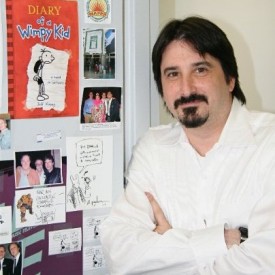Every month or two, DIY MFA’s Wendy Lu will be hosting “New Spin,” a column that covers everything that falls within alternative storytelling: literary mash-ups, books that put a new spin on classic stories, and “meta-books” that use new media, graphic illustrations, and interaction between words/design for an enhanced reader experience.
Whether your English teacher required a marble notebook for class or you stashed a diary with its own metal lock and lucky green pen under the bed, chances are you wrote in a journal as a kid. You might’ve even kept the hobby up well into adulthood, like New York Times bestselling author Jeff Kinney did before he created a children’s book series inspired by his own journals.
“Diary of a Wimpy Kid” is well-known in children’s literature as an ongoing series of epistolary novels written from the perspective of a young schoolboy named Greg Heffley. In each book, Greg documents the trials of middle school life with short diary entries complemented with funky cartoon drawings. Sounds like the perfect coming-of-age book series any child would want to read.
Except “Diary of a Wimpy Kid” was never meant to be for, well, kids.
Building the Wimpy Kid Universe
Like any young adult hoping to break into the creative field, Jeff Kinney was in his late twenties when he struggled to sell his cartoons. Around the same time, he kept a journal that was comprised of “text sprinkled with illustrations.” After finding no demand for his cartoons from newspaper syndicates, he decided to present his artwork in a new way, influenced by the formatting of his journals: book form.
“That was my breakthrough moment,” Kinney says, recalling the birth of his first manuscript and Greg Heffley’s first diary, which was published by Abrams Books in 2007.
At first, Kinney imagined his 1,300 draft would be a book for adults, not children. He worked with the editor, Charles Kochman, to determine what the basic structure and characters would be like.
“At first, we were thinking of [“Diary of a Wimpy Kid”] as one large volume for adults, telling a story in much the same way the TV show “The Wonder Years” was a story that looked back on childhood,” says Kochman, editorial director of Abrams ComicArts. “But the more we discussed the approach, the more it made sense to make this a series for younger readers. There’s such a long tradition of happy accidents—of something starting out as one thing and becoming another—and that unexpected twist makes the experience of Wimpy Kid even more satisfying.”
Kinney’s “kid-lit” bestsellers aren’t the first epistolary novels to join the market. Books in the form of letters and journal entries written by the main characters have been popular for years, from “The Perks of Being a Wallflower” and “The Princess Diaries” to “The Color Purple.”
What makes “Diary of a Wimpy Kid” stand out from its counterparts are the quirky, satirical jokes that make up the foundation of Greg Heffley’s diaries. As Greg describes his first day of school and how he’s able to get by without doing too much schoolwork since the students are new, we get a sketch of Greg’s gaudy-looking teacher asking him a question, to which Greg replies, “No speech English.”
Though the “Diary of a Wimpy Kid” books are considered to be novels, Kinney says the storytelling isn’t quite as significant as the joke-telling. That’s why, when developing a new book for the series, Kinney spends a few months coming up with jokes first – at least 350 of them – before even getting started on the manuscript. The drawings come last.
“As much as possible, I try to deliver the jokes in the artwork,” Kinney says. “I don’t like it when my artwork is merely descriptive. What makes this format work is when the artwork and text play off of each other.”
As Kinney develops the book’s basic plot, he’ll bounce ideas off of Kochman and get his perspective to make sure the overall storyline makes sense.
“Once he writes the first draft, which doesn’t have any of the illustrations in it, I’ll get on a train and spend a few days sitting side by side with him in his studio going over the book page by page,” Kochman says. With him and three other editors– including the publisher – reviewing Kinney’s draft, there are enough pairs of eyes to provide different perspectives on story flow and language.
Even after Kinney finishes a manuscript, the creative process is far from over. Months before the book is ready for print, they enlist the help of the art director, production manager and even the CEO to discuss the minutest of details – everything from the cover art and color of the book to the title and back cover copy must be tweaked with and finalized before publication.
It’s essential for each book to have its own fresh, new cover that’s both distinct and still fits with the rest of the series, Kochman says. Sometimes, the overall book design and title will take months. Sometimes, it’s a no-brainer.
“For this [most recent] book, Jeff came up with the title right away. It was hard to imagine it being anything else,” he says.
The “Diary of a Wimpy Kid” franchise includes nine books printed in 45 languages, with more than 115 million copies across the globe. The cover, title and color of the 10th book, “Diary of a Wimpy Kid: Old School,” was revealed on April 27 as part of the inaugural Wimpy Kid Month, an annual celebration of Kinney’s book series. The 10th diary is set to be published in November.
It’s happening! #Repost @diaryofawimpykid: Here’s a behind the scenes look at today’s #Wim… https://t.co/42cQUgSxMu pic.twitter.com/eGFiJQfNGE
— ABRAMS (@ABRAMSbooks) April 27, 2015
Fitting into the World of Kid Lit
In a category where Ramona Quimby, Peter Hatcher, Percy Jackson and the Baudelaire siblings thrive, “Dairy of a Wimpy Kid” protagonist Greg Heffley is just like any other middle schooler. He’s competitive with his best friend Rowley, he likes getting noticed for his hard work and he hopes to gain the respect of his peers by reaching the social status of “Class Clown.”
Like many admirable children’s books, what’s noteworthy about “Diary of a Wimpy Kid” is that any kid can relate to Greg – he doesn’t possess the traits of a typical hero, and good things don’t happen often to him. He’s prone to making mistakes like the rest of us. But every once in a while, he’ll sacrifice his reputation or another personal gain for the sake of his friends, proving that Greg Heffley really isn’t all that wimpy.
At the same time, Kochman says the books are inventive because they go against the conventional wisdom that boys don’t read or like to write, much less journal. And the very nature of the “Wimpy Kid” books – the fact that it’s neither a traditional chapter book nor a graphic novel – makes Greg’s story different, and have sparked a new genre of ‘diary fiction’ for middle-grade readers. Since the first book’s publication in 2007, kids all over the world have been gulping his diary entries down like water.
Many of the humorous stories in Greg’s diaries are derived from Kinney’s own childhood experiences, according to Kochman.
“Jeff’s a keen observer of behavior, finding the quirky and the awkwardness we all share but never really thought much of until he put his finger on just how quirky and awkward our lives are,” he says.
For authors who are trying to break into children’s literature, Kinney offers this nugget of wisdom: Children are smarter than you may think – don’t write down to them.
“Many adults who write for kids think there needs to be a baked-in lesson. Kids can sniff that out,” Kinney says. “It’s important to write in an honest way and not pander.”
In order to succeed in the book business, Kochman says novelty is key. In the same way that Jeff Kinney created a trend with “Diary of a Wimpy Kid,” children’s authors should strive to come up with their own innovation.
“Any writer can jump on a trend and make a buck. And there’s nothing wrong with that, if that’s your motivation for writing,” he says. “But the books that have the most permanence are always the ones that articulate something that hasn’t been articulated before. They take risks and go against a reader’s preconceived notions and expectations.”
For author-illustrators like Jeff Kinney, developing a style that can be instantly recognizable and belongs to them alone is also necessary.
“Contemporary artists such as Jason Shiga, Barry Deutsch, Patrick McDonnell, and even Jeff Kinney – you can recognize their art instantly. Countless artists came before each of them, and yet each of these artists, using the same tools as any other creator, developed a look, a style and a series of characters that hadn’t existed before they started to express themselves visually,” Kochman says. “To me, that’s the goal: to stand out and be original.”
Greg Heffley Isn’t Going Anywhere
We’ve seen the star of “Diary of a Wimpy Kid” move through three grades in middle school, get a brand new dog, experience puberty and even lose a Valentine’s date to his best friend. If you’re anxious about Greg Heffley growing up and out of his diary phase, rest assured: he won’t stop journaling anytime soon. Kinney says he hopes for the “Wimpy Kid” series to have at least 20 books following Greg’s adventures, and there’s even talk of rebooting the movies.
Additionally, with book “extras” like a movie diary and do-it-yourself journal, kids can enjoy the Wimpy Kid Universe as it continues to expand beyond the actual series.
“I think kids enjoy the Wimpy Kid Universe as a whole, and like the supplemental material as long as it’s high-quality. It’s really important that the ancillary material has been given the care of the ‘real thing.’ Otherwise, it falls flat,” says Kinney, who plans to open a bookstore in Plainville, M.A., his current hometown, in the coming weeks.
In addition to his work with the “Diary of a Wimpy Kid” team at Abrams Books, Kinney also serves as the founder and creative director for Poptropica.com.
“Jeff has an incredible amount on his plate at all times, and yet year after year he continues to challenge himself to create a new [“Wimpy Kid”] book that’s as funny, or funnier, than the previous books,” Kochman says.
With at least 10 more books to go in the series, Kinney says he hopes to sustain Greg Heffley’s character for a long period of time.
“The best cartoon characters don’t age,” Kinney says. “That’s what we love about them.”
Photo Credit: woodleywonderworks (Flickr)
~ ~ ~
Author bio:
 Jeff Kinney is an online game developer and designer, and a #1 New York Times bestselling author. Jeff was named one of Time magazine’s 100 Most Influential People in the World. He spent his childhood in the Washington, D.C., area and moved to New England in 1995. Jeff lives in southern Massachusetts with his wife and their two sons.
Jeff Kinney is an online game developer and designer, and a #1 New York Times bestselling author. Jeff was named one of Time magazine’s 100 Most Influential People in the World. He spent his childhood in the Washington, D.C., area and moved to New England in 1995. Jeff lives in southern Massachusetts with his wife and their two sons.
Editor Bio:
 Charles Kochman is the editorial director of Abrams ComicArts and the editor of the #1 bestselling series “Diary of a Wimpy Kid” by Jeff Kinney. Kochman has edited several hundred books for all age groups, including picture books, middle-grade novels, award-winning graphic novels and much more. Prior to Abrams, Kochman spent 12 years as the first editor of licensed publishing at DC Comics and Mad Magazine, where he launched the Mad Books imprint and edited the company’s first New York Times bestseller, “The Death and Life of Superman.”
Charles Kochman is the editorial director of Abrams ComicArts and the editor of the #1 bestselling series “Diary of a Wimpy Kid” by Jeff Kinney. Kochman has edited several hundred books for all age groups, including picture books, middle-grade novels, award-winning graphic novels and much more. Prior to Abrams, Kochman spent 12 years as the first editor of licensed publishing at DC Comics and Mad Magazine, where he launched the Mad Books imprint and edited the company’s first New York Times bestseller, “The Death and Life of Superman.”
DIY MFA Columnist Bio:

Wendy Lu is a features writer, lifestyle blogger and a recent graduate of UNC School of Journalism and Mass Communication. She writes web content for Personify and most recently served as content curator for Everyday Ambassador’s “Digital Detox” weekly series. Previously, she was the managing editor for UNC’s Blue & White Magazine and co-editor for The Durham VOICE. She has written for multiple publications, including China.org.cn, Her Campus, Raleigh Public Record, Chapel Hill’s The WEEKLY and The Daily Tar Heel. Learn more about Wendy at https://wendyluwrites.com.







